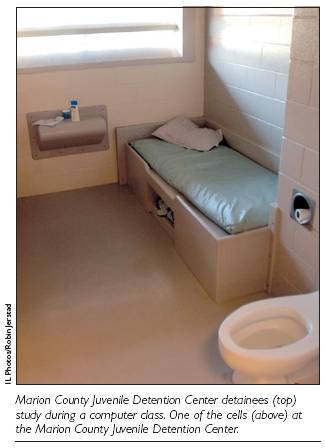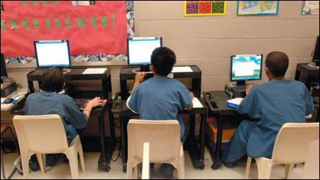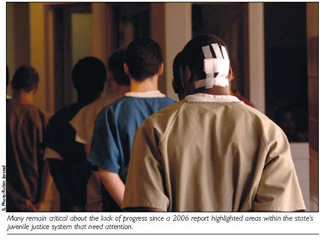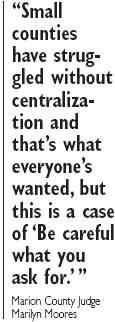Subscriber Benefit
As a subscriber you can listen to articles at work, in the car, or while you work out. Subscribe NowWhat happens in the courtroom is only one piece of the juvenile justice puzzle. Youth detention and alternative detention programs represent costly components of the juvenile justice system that are currently experiencing some of the most dramatic reforms at the state level. Amid court challenges and legislative changes, detention funding questions are arising at a time when Indiana ranks fourth in the nation for how many children it locks up and as counties push alternative programs designed to limit the number of juveniles being sent to state and secure detention facilities.
A report released in early April by a national child advocate group, the Every Child Matters Education Fund based in Washington, D.C., shows that Indiana's per capita juvenile incarceration rate for children ages 10 through 17 is 415.4 per 100,000 juveniles. Only Florida, South Dakota, and Wyoming have worse records. And Indiana is 473 percent higher than the Vermont, the state that locks up the fewest juveniles. The report states that juveniles in the worst 10 states are more than twice as likely to be incarcerated as those in the best-ranked states.

Indiana Department of Correction figures show that about 1,014 juveniles were incarcerated as of Jan. 1, 2008, at the state's seven facilities, a steady increase from previous reports. More than 80 percent are males.
"Detention isn't good for kids," Marion Juvenile Judge Marilyn Moores said."When you put (juvenile) shoplifters with kids charged with armed robbery, that shoplifter is going to rise to that higher level not the opposite."
Detention decisions
At the local level, Hoosier counties can look at their own jurisdictions and see a reflection of the report's findings, though many are working to limit the number of juveniles locked up in favor of placement alternatives. There are about two dozen secure detention facilities in Indiana, with local juvenile courts or county officials administering most of them and traditionally using county funds to pay detention costs.
Late last year, St. Joseph Juvenile Judge Peter Nemeth stopped sending female offenders to a state-run juvenile center in Indianapolis because he felt it lacked sufficient staffing and adequate services; in an open letter to Gov. Mitch Daniels, he cited claims of girls being "warehoused" and accusations of sexual contact.
The Marion County Juvenile Detention Center has undergone a transformation since a 2006 investigation and audits found unsafe conditions for staff and detainees — concerns echoed at facilities nationwide and spelled out in lawsuits against facilities in at least 11 states in recent years. In the state's largest county, the U.S. Department of Justice has scrutinized the county-run juvenile detention center for nearly two years because of concerns about issues such as violence and education, but earlier in April the federal department filed a settlement agreement to continue monitoring for another three years to make sure improvements are being made.
Judge Moores is proud of the alternative detention options the county has utilized, as well as a new risk-assessment tool being used to determine whether kids should be detained. Since she took the bench in 2005 and the detention center's jurisdiction shifted from the Juvenile Court to the Superior Court Executive Committee, the 144-bed facility has gone from average daily populations of about 200 — with kids staying on cots and floors to a current average daily population in the mid- to high 90s, according to her court's figures.
While some counties can be seen as examples of why detention shouldn't be the first or most common option chosen when deciding how to handle juvenile offenders, the reform efforts can be commendable, advocates say. But so much of it comes to funding, and they admit that's part of the problem now facing the juvenile justice system.
Funding
 Detention alternatives work the best, as juveniles and those in the trenches point out, but it can be difficult to utilize in areas of Indiana where funding and resources are scarce.
Detention alternatives work the best, as juveniles and those in the trenches point out, but it can be difficult to utilize in areas of Indiana where funding and resources are scarce.
"We have too many kids we throw away," said Janet Peterson, a Lake County supervisor for the Indiana Juvenile Justice Task Force. "We have programs that work and can stop them from becoming a permanent problem in the adult system."
In Marion County alone, about 300 youths were securely detained in 2007 who would have been released had additional appropriate alternatives to secure detention been available, according to Gael Deppert, who leads the Marion County Juvenile Detention Alternative Initiative. The total price tag came to almost $1.14 million last year for those juveniles, breaking down to about $253 per day to detain a juvenile and an average of about $3,795 per child for an average 15-day stay.
That's not even looking at overall child-welfare costs, estimated to be about $100 million a year in the county. The statewide costs are in the ballpark of $440 million annually to provide services to abused and neglected children and families, and youth in the juvenile justice system.
In Wayne County, public defender Kaarin Lueck said that too often the only option is secure detention because alternatives aren't available in more rural counties.
"You have to turn to the DOC, and that's not the intent of the delinquency system," she said.
That funding issue is now one that's playing out on two fronts — the Indiana Court of Appeals and the General Assembly. The COA is considering Marion County and St. Joseph County v. State of Indiana, 73A01-0705-CV-238, which has statewide implications regarding who must pay to operate juvenile detention facilities the state or individual counties. The counties sued in 2005 after Indiana tried to recover about $75 million it spent operating juvenile detention facilities in those two areas, and a Shelby County judge last spring ruled in favor of the state.
During arguments April 17, the counties argued that a 1953 law violated the Indiana Constitution when it allowed the state to charge counties for housing juveniles in the Indiana boys' and girls' schools, now the Indianapolis Juvenile Correctional Facility.
 That case comes just as the state's juvenile justice system is prepping for a new law to begin next year, effectively shifting juvenile detention costs from the counties to the state.
That case comes just as the state's juvenile justice system is prepping for a new law to begin next year, effectively shifting juvenile detention costs from the counties to the state.
Buried within hundreds of pages of sweeping property tax reform passed by the General Assembly this year and signed into law by the governor in March are several provisions that mean juvenile courts could lose some say on children in the state's care.
Juvenile judges, attorneys, and advocates worry what the new law will mean for children in the system, while proponents emphasize how this will expand Indiana's ability to collect federal reimbursements and make the process more efficiently centralized through the Indiana Department of Child Services.
Key parts of the law impacting the juvenile justice system include:
• DCS must sign off on plans ordered by judges for abused and neglected children and their families, and juvenile courts must submit recommendations for services, programs, or placements of a delinquent child to DCS for preapproval.
• Provides the DCS is not responsible for the costs of child services if the juvenile court has not entered the required findings and the DCS has determined the child otherwise meets the Title IV-E eligibility requirements.
• In all cases, if the juvenile court orders services, programs, or placements that are not eligible under Title IV-B or Title IV-E and are not recommended or approved by the DCS, the DCS is not responsible to pay the costs of those services, programs or placements.
• If either party doesn't agree with the other's findings, the court or DCS can appeal to the Indiana Court of Appeals and go through an expedited appellate review process that's currently being established.
 Indiana Chief Justice Randall T. Shepard doesn't see danger, although he admits it will take time to sort through the enormous changes and opposition is likely because of the traditional local control.
Indiana Chief Justice Randall T. Shepard doesn't see danger, although he admits it will take time to sort through the enormous changes and opposition is likely because of the traditional local control.
"It's far from certain where all of this will shake out, but it's all about doing what's favorable to the interests of children," he said. "Kids won't get shuffled back and forth depending on who's paying the bill."
Lake Juvenile Judge Mary Beth Bonaventura said she has confidence that the DCS wants to do right by kids and that obstacles in this law can be overcome, including the concerns about a tighter timeline in making some of these juvenile justice decisions.
"This certainly is going to put a new spin on what we do, but the courts will ultimately decide what's in the best interest of the children," she said.
The DCS and director James Payne, former juvenile judge in Marion County, did not return phone calls or e-mails from Indiana Lawyer seeking an interview for this story.
In Marion County, Judge Moores predicts the changes will create funding challenges for the juvenile court system. While the state is picking up the tab for state-detained juveniles, it isn't taking responsibility for all the services and programs currently being paid through the county funds. That means alternative detention programs and mental health diversion programs in place statewide could be in danger, unless counties find a way to raise money for those options, she said.
 "Small counties have struggled without centralization and that's what everyone's wanted, but this is a case of 'Be careful what you ask for.' The entire funding system is being centralized, and this is akin to the executive branch trying to direct the judicial. I certainly understand the need for a homogenous approach across the state, but this may have unintended consequences that do more harm than good."
"Small counties have struggled without centralization and that's what everyone's wanted, but this is a case of 'Be careful what you ask for.' The entire funding system is being centralized, and this is akin to the executive branch trying to direct the judicial. I certainly understand the need for a homogenous approach across the state, but this may have unintended consequences that do more harm than good."
Amy Karozos, an attorney with the Youth Law T.E.A.M. of Indiana and chair of the Indiana State Bar Association's Civil Rights of Children Committee, worries that more secure detentions or DOC placements could result from this new law.
"That's a possibility because there won't be as many options or services as there were to kids in the delinquency system," she said. "But right now, no one is sure what effects it may have."
Advocates working on the front lines remain optimistic, despite the obstacles.
Alternative detention efforts will continue trying to cut the number of incarcerated youth, even as juvenile justice officials work to sort out funding and procedural questions, they say.
"We're the early warning system for the entire criminal justice system, and we need to get at the root of the problem," Judge Moores said. "Detention and alternatives should be nurturing and educational for kids … . We're not there yet, and it's disappointing, but Rome wasn't built in a day."
Please enable JavaScript to view this content.
